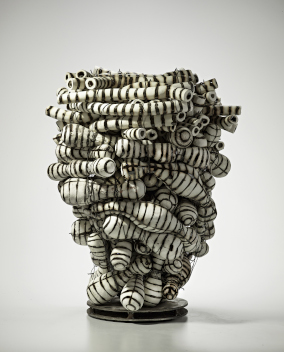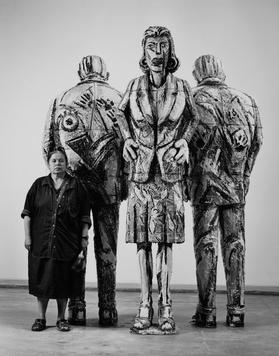
Studio pottery is pottery made by professional and amateur artists or artisans working alone or in small groups, making unique items or short runs. Typically, all stages of manufacture are carried out by the artists themselves. Studio pottery includes functional wares such as tableware and cookware, and non-functional wares such as sculpture, with vases and bowls covering the middle ground, often being used only for display. Studio potters can be referred to as ceramic artists, ceramists, ceramicists or as an artist who uses clay as a medium.
Toshiko Takaezu was an American ceramic artist, painter, sculptor, and educator who was known for her rounded, closed forms that viewed ceramics as a fine art and more than a functional vessel. She is of Japanese descent and from Pepeeko, Hawaii.
Edith Kiertzner Heath was an American studio potter and founder of Heath Ceramics. The company, well known for its mid-century modern ceramic tableware, including "Heathware," and architectural tiles, is still operating in Sausalito, California, after being founded in 1948.

Mary Lee Hu is an American artist, goldsmith, and college level educator known for using textile techniques to create intricate woven wire jewelry.

Annabeth Rosen is an American sculptor best known for abstract ceramic works, as well as drawings. She is considered part of a second generation of Bay Area ceramic artists after the California Clay Movement, who have challenged ceramic traditions involving expression, form and function and helped spur the medium's acceptance in mainstream contemporary sculpture. Rosen's sculptures range from monumental to tabletop-sized, and emerge out of an accumulative bricolage process combining dozens or hundreds of fabricated parts and clay fragments and discards. Reviewers characterize her art as deliberately raw, both muscular and unapologetic feminine, and highly abstract yet widely referential in its suggestions of humanoid, botanical, aquatic, artificial, even science-fictional qualities. Critic Kay Whitney wrote that her work is "visceral in its impact, violent even, but also sensual and evocative" and "floats between the poles of the comic and the mordant."

Viola Frey was an American artist working in sculpture, painting and drawing, and professor emerita at California College of the Arts. She lived and worked in the San Francisco Bay Area and was renowned for her larger-than-life, colorfully glazed clay sculptures of men and women, which expanded the traditional boundaries of ceramic sculpture.

Howard William Kottler was an American ceramist, conceptual artist, and professor of ceramics at the University of Washington, credited as a seminal force in redefining the direction of contemporary American ceramic art.
Patti Warashina is an American artist known for her imaginative ceramic sculptures. Often constructing her sculptures using porcelain, Warashina creates narrative and figurative art. Her works are in the collection of the Museum of Arts and Design, New York, National Museum of Modern Art, Kyoto, and the Smithsonian American Art Museum.

Gertrud Amon Natzler was an Austrian-American ceramicist, who together with her husband Otto Natzler created some of the most praised ceramics art of the 20th century, helping to elevate ceramics to the status of a fine art.
Beth Lo in Lafayette, Indiana is an American artist, ceramist and educator. Her parents emigrated from China.

Harrison Edward McIntosh was an American ceramic artist. He was an exponent of the Mid-century Modern style of ceramics, featuring simple symmetrical forms. His work has been exhibited in venues in the United States including the Smithsonian and internationally including at the Louvre in France.
Susan Hale Kemenyffy is an American artist who works primarily in drawing and print media. She is known for the innovative raku art she created in collaboration with her husband Steven Kemenyffy.
Richard Shaw is an American ceramicist and professor known for his trompe-l'œil style. A term often associated with paintings, referring to the illusion that a two-dimensional surface is three-dimensional. In Shaw's work, it refers to his replication of everyday objects in porcelain. He then glazes these components and groups them in unexpected and even jarring combinations. Interested in how objects can reflect a person or identity, Shaw poses questions regarding the relationship between appearances and reality.

Donald Lester Reitz was an American ceramic artist, recognized for inspiring a reemergence of salt glaze pottery in United States. He was a teacher of ceramic art at the University of Wisconsin–Madison from 1962 until 1988. During this period, he adapted the pottery firing technique developed in the Middle Ages, which involved pouring salt into the pottery kiln during the firing stage. The method was taught in European ceramic art schools, but largely unknown in United States studio pottery.
John Walker Wick was an American ceramicist. Though open to artistic experimentation, Glick was most influenced by the styles and aesthetics of Asian pottery—an inspiration that shows in his use of decorative patterns and glaze choices. His experience working with ceramics led him to publish several articles about the craft. In addition to producing pottery, Glick began making "landscape oriented" wall panels during the latter part of his career. Known as "the people's potter," he is primarily remembered for his contributions to art and the field of ceramics.
Karen Thuesen Massaro is a ceramicist working in the United States known for creating unconventional arrangements of sculptural objects through her work. Interested in exploring abstraction, she has experimented with a variety of different themes including the repetition of forms and surface textural change, negative space, and the geometric patterning of natural objects. Massaro creates much of her artwork by taking casts of physical objects, like fruit, molding them out of clay, and decorating them with patterns. Her manipulations make common objects feel less ordinary. These experiments allow her to explore color and form in complex ways.
Chris Gustin is an American ceramicist. Gustin models his work on the human form, which is shown through the shape, color, and size of the pieces.
Nan Bangs McKinnell (1913–2012) was an American ceramicist and educator. Nan was a founding member of the National Council on Education for the Ceramic Arts, a member of the American Craft Council College of Fellows, along with receiving several awards for her work. James "Jim" McKinnell (1919–2005), her spouse, was also a ceramicist and they made some collaborative work.

Nancy Selvin is an American sculptor, recognized for ceramic works and tableaux that explore the vessel form and balance an interplay of materials, minimal forms, and expressive processes. She emerged in the late 1960s among a "second generation" of Bay Area ceramic artists who followed the California Clay Movement and continued to challenge ceramic traditions involving expression, form and function, and an art-world that placed the medium outside its established hierarchy. Her work has been exhibited at the Los Angeles County Museum of Art (LACMA), Denver Art Museum, Daum Museum of Contemporary Art and Kohler Arts Center, and belongs to the public art collections of LACMA, the Smithsonian Institution, Oakland Museum of California, and Crocker Art Museum, among others. Critic David Roth has written, "Selvin's position in the top rank of ceramic artists has come through a process of rigorous self-examination … what differentiates [her] is that she eschews realism and functionality, indicating a level of intellectual engagement not always found among ceramicists." Writer and curator Jo Lauria described Selvin's tableaux as "elegiac and stylistically unified" works that serve as "forceful essays on the relationship between realism and abstraction, object and subject, decoration and use." Selvin lives and works in the Berkeley, California area.

Paul Chaleff is an American ceramist and professor emeritus of Fine Arts at Hofstra University. He is considered a pioneer of the revival of wood-fired ceramics in the US and credited as one of the first to use wood-burning dragon kilns in the style of the anagama tradition. He is best known as an innovator of large-scale ceramic sculpture. His work can be found in the collections of the Museum of Modern Art Department of Architecture and Design, and in the Metropolitan Museum of Art.









